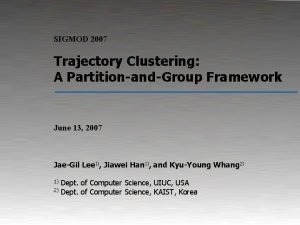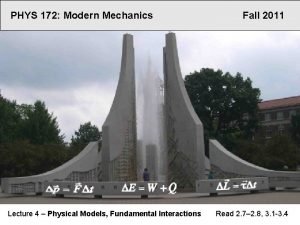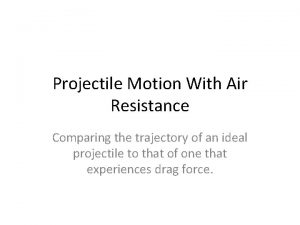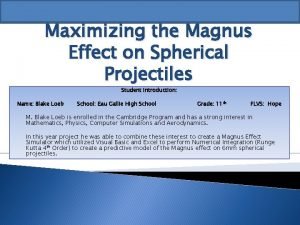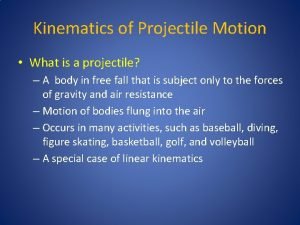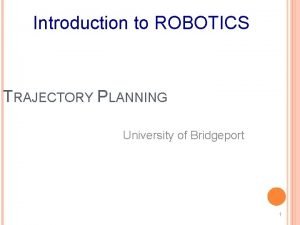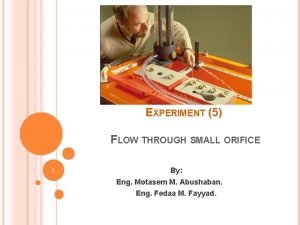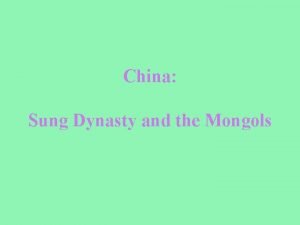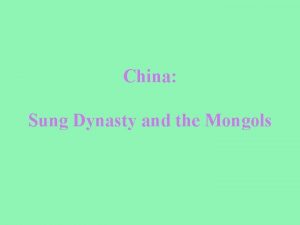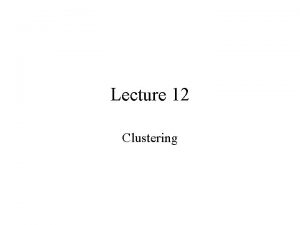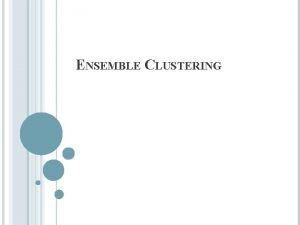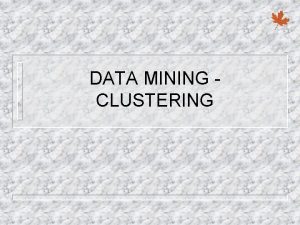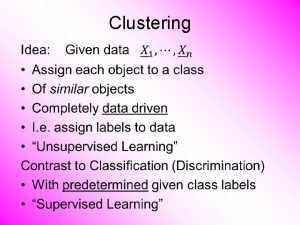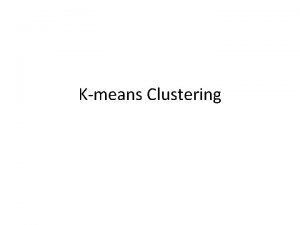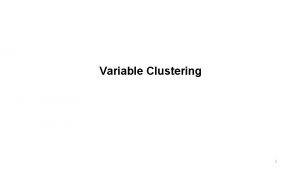Trajectory Clustering for Motion Prediction Cynthia Sung Dan





![Algorithm Overview 1: Line simplification • [Hönle et al, 2010; Douglas and Peucker, 1973] Algorithm Overview 1: Line simplification • [Hönle et al, 2010; Douglas and Peucker, 1973]](https://slidetodoc.com/presentation_image_h2/b0b60ce3f61a9be74ac2271b62a93dea/image-6.jpg)

![Algorithm Overview 3: Interval Clustering • [Lymberopoulos et al, 2009] 7 Algorithm Overview 3: Interval Clustering • [Lymberopoulos et al, 2009] 7](https://slidetodoc.com/presentation_image_h2/b0b60ce3f61a9be74ac2271b62a93dea/image-8.jpg)






- Slides: 14

Trajectory Clustering for Motion Prediction Cynthia Sung, Dan Feldman, Daniela Rus October 8, 2012

Background Trajectory Clustering Noise Sampling frequency Inaccurate control 1

Background Related Work SLAM [Ranganathan and Dellaert, 2011; Cummins and Newman, 2009; Durrant-Whyte and Bailey, 2006; Fox et al, 2006; Choset and Nagatani 2001] Tracking, Interception, Avoidance [Joseph et al, 2011; Rubagotti et al, 2011; Vasquez et al, 2009; Bennewitz et al, 2004; Chakravarthy and Ghose, 1998] De-noising [Hönle et al, 2010; Barla et al, 2005; Cao et al, 2006; Lerman, 1980; Douglas and Peucker, 1973; Bellman, 1960] Trajectory clustering [Ying et al, 2011; Chen et al, 2010; Sacharidis et al, 2008; Lee et al, 2007; Nanni et al, 2006; Fu et al, 2005; Keogh & Pazzani, 2000; Agrawal et al, 1993] 2

Trajectory Clustering Problem: Given a trajectory T, find a set of motion patterns R such that T can be approximated by a sequence of elements from R 2 1 2 1 3

Algorithm Overview Clustering Overview Original Trajectory Line Simplification Interval Clustering k-lines Projection Final Approximation 4
![Algorithm Overview 1 Line simplification Hönle et al 2010 Douglas and Peucker 1973 Algorithm Overview 1: Line simplification • [Hönle et al, 2010; Douglas and Peucker, 1973]](https://slidetodoc.com/presentation_image_h2/b0b60ce3f61a9be74ac2271b62a93dea/image-6.jpg)
Algorithm Overview 1: Line simplification • [Hönle et al, 2010; Douglas and Peucker, 1973] 5

Algorithm Overview 2: k-lines projection • 6
![Algorithm Overview 3 Interval Clustering Lymberopoulos et al 2009 7 Algorithm Overview 3: Interval Clustering • [Lymberopoulos et al, 2009] 7](https://slidetodoc.com/presentation_image_h2/b0b60ce3f61a9be74ac2271b62a93dea/image-8.jpg)
Algorithm Overview 3: Interval Clustering • [Lymberopoulos et al, 2009] 7

Algorithm Overview Final Representation Input: line segments (step 1), clustering (step 3) Output: motion patterns 8

Results Frequency Plots Manual Clustering frequency Original Trajectory Our Algorithm Purity: 84. 9% k-means Purity: 68. 6% Data source: Oxford Mobile Robotics Group 9

Results frequency Frequency Plots Original Trajectory Manual Clustering Our Algorithm Purity: 75. 9% k-means Purity: 54. 5% Data source: CRAWDAD data set rice/ad hoc city 10

Simulations Application to Interception 1. Find motion patterns in the observed trajectory 2. Fit a Hidden Markov Model (HMM) to the pattern sequence 3. Predict future motion 4. Plan a path to the predicted interception point with the object 11

Simulations Comparisons of Interception Planning N = 100 Q 1 Q 2 Q 3 0. 8 12. 7 15. 5 Data-driven motion prediction 0. 3 1. 4 13. 4 Data-driven motion prediction Constant velocity assumption 12

Summary Data-Driven Interception Planning Novel trajectory clustering algorithm • Applicable to high dimensional trajectories • Higher quality approximation than current methods Simulations demonstrate benefits to interception planning Support for this project has been provided in part by the Future Urban Mobility project of the Singapore-MIT Alliance for Research and Technology (SMART) Center, with funding from Singapore’s National Research Science Foundation, by the Foxconn Company, by ONR MURI grants N 00014 -09 -1 -1051 and N 00014 -09 -1 -1031, and by NSF award IIS-1117178. 13
 The trajectory
The trajectory Flat cluster
Flat cluster Partitional clustering
Partitional clustering Flat clustering vs hierarchical clustering
Flat clustering vs hierarchical clustering Phys 172
Phys 172 Trajectory with air resistance
Trajectory with air resistance Vfy=viy+gt
Vfy=viy+gt Trajectory formula
Trajectory formula Magnus force formula
Magnus force formula Vertical component of projectile motion
Vertical component of projectile motion Trajectory planning matlab code
Trajectory planning matlab code Radial nerve trajectory
Radial nerve trajectory A factor that affects the flight of a projectile
A factor that affects the flight of a projectile Trajectory schema examples
Trajectory schema examples Flow through small orifice
Flow through small orifice
